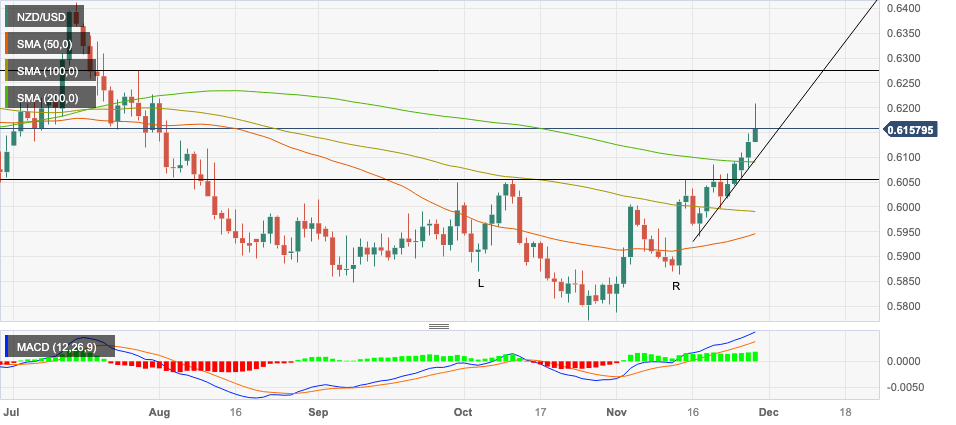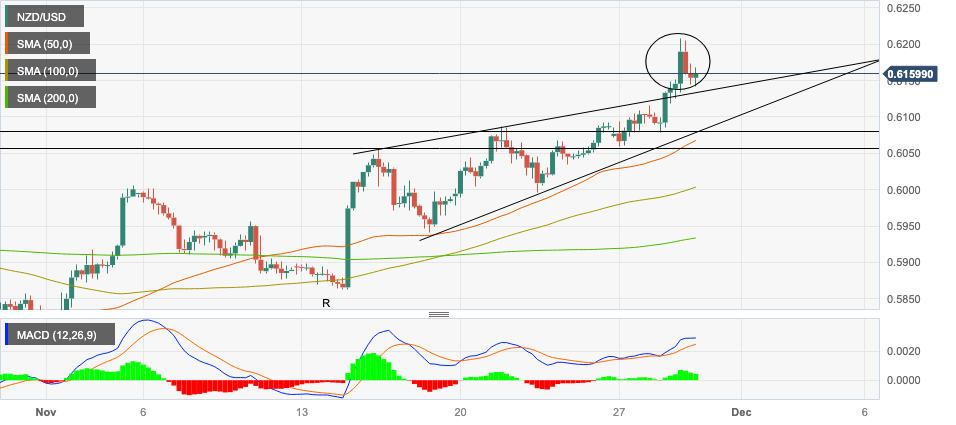New Zealand Dollar gives back some gains following RBNZ-led rally
- The New Zealand Dollar surged higher following the RBNZ policy meeting on Wednesday but then gave up gains.
- Although the RBNZ left interest rates unchanged, commentary from Governor Orr suggested the possibility of further rate hikes.
- NZD/USD pushed to a new peak above 0.6200 following the meeting, extending its short-term uptrend.
The New Zealand Dollar (NZD) rallied on Wednesday against the US Dollar (USD) following the Reserve Bank of New Zealand (RBNZ) meeting in the early hours. However, the NZD/USD pair's intraday high at 0.6208 during the Asian session has pulled back all the way to 0.6149 at the time of writing during the late US session. This still amounts to a 0.22% intraday gain.
Although the RBNZ left the Official Cash Rate unchanged, the Kiwi rose after RBNZ Governor Adrian Orr said he would not rule out further interest rate hikes if inflation remained elevated. The prospect of higher interest rates is bullish for currencies as it attracts higher capital inflows.
Daily digest market movers: New Zealand Dollar surges after RBNZ meeting
- The New Zealand Dollar rallies after the RBNZ Governor mentions the possibility interest rates could rise even higher in the future, depending on the outlook for inflation.
- The bank left the Official Cash Rate (OCR) at 5.50% at the meeting, however, as markets had expected.
- The hawkish tone of press conference after the meeting surprised many investors as New Zealand data – though still elevated – has come out below expectations recently, suggesting, if anything, interest rates are at risk of being cut.
- Official data from Statistics New Zealand (Stats NZ) showed that the Consumer Price Index (CPI) in the 12 months to September rose 5.6%, lower than expectations of 5.9% and the prior quarter’s reading of 6.0%. On a quarterly basis, New Zealand’s inflation increased to 1.8% but fell short of expectations of 2.0%.
- New Zealand's Unemployment Rate climbed to 3.9% in the September quarter, compared with 3.6% last quarter.
- The new center right-wing coalition government has plans to change the RBNZ’s dual mandate, which combines maintaining price stability with full employment. They want to scrap the employment part and for the RBNZ to focus on price stability.
- Preliminary talks between the new government and RBNZ officials were characterized as being “constructive” by Orr, suggesting the bank may be open to changing to a single mandate.
- Such a move would enable the RBNZ to be more single-minded about bringing inflation down using higher interest rates and regardless of the impact on the economy and labor market, it thus could be viewed as a hawkish development and bullish for NZD.
New Zealand Dollar technical analysis: NZD/USD peaks above 0.6200
NZD/USD – the number of US Dollars that can be bought with one New Zealand Dollar – peaks above 0.6200 after rallying following the RBNZ policy meeting. Although it has pulled back down since, the pair remains in a short and medium-term bullish trend, which continues to bias longs over shorts.
The MACD momentum indicator is rising in line with price suggesting the short and medium-term uptrend is healthy.

New Zealand Dollar vs US Dollar: Daily Chart
Last night’s post-RBNZ surge means a possible bullish inverse head and shoulders (H&S) pattern which formed at the autumn lows has almost reached its conservative price target of 0.6215.
The pair may be in the process of forming a bearish shooting star Japanese candlestick pattern on Wednesday. If the candlestick retains its shape at the end of the day and is followed by a strong bearish candle on Thursday, it could signal a short-term bearish correction.
A break above the current 0.6208 highs, however, would add impetus to the short and medium-term uptrend. The next major resistance level is then at 0.6238, where the 100-week Simple Moving Average (SMA) resides followed by 0.6274, the July 27 highs.

New Zealand Dollar vs US Dollar: 4-hour Chart
A possible bearish ending wedge price pattern, which formed on the 4-hour chart, failed to signal a move lower as price actually broke out to the upside extending the uptrend. Whilst this could mark an exhaustion move more downside would be required to confirm.
A possible tweezer top Japanese candlestick reversal pattern may have formed at the highs (circled). This is a short-term bearish signal. The pair is already finding support from the upper boundary line of the wedge at 0.6140. If it pulls back any lower, it could find support at the lower boundary line, at 0.6080.
The long-term trend is still overall bearish, suggesting a risk of a recapitulation remains.
New Zealand Dollar FAQs
What key factors drive the New Zealand Dollar?
The New Zealand Dollar (NZD), also known as the Kiwi, is a well-known traded currency among investors. Its value is broadly determined by the health of the New Zealand economy and the country’s central bank policy. Still, there are some unique particularities that also can make NZD move. The performance of the Chinese economy tends to move the Kiwi because China is New Zealand’s biggest trading partner. Bad news for the Chinese economy likely means less New Zealand exports to the country, hitting the economy and thus its currency. Another factor moving NZD is dairy prices as the dairy industry is New Zealand’s main export. High dairy prices boost export income, contributing positively to the economy and thus to the NZD.
How do decisions of the RBNZ impact the New Zealand Dollar?
The Reserve Bank of New Zealand (RBNZ) aims to achieve and maintain an inflation rate between 1% and 3% over the medium term, with a focus to keep it near the 2% mid-point. To this end, the bank sets an appropriate level of interest rates. When inflation is too high, the RBNZ will increase interest rates to cool the economy, but the move will also make bond yields higher, increasing investors’ appeal to invest in the country and thus boosting NZD. On the contrary, lower interest rates tend to weaken NZD. The so-called rate differential, or how rates in New Zealand are or are expected to be compared to the ones set by the US Federal Reserve, can also play a key role in moving the NZD/USD pair.
How does economic data influence the value of the New Zealand Dollar?
Macroeconomic data releases in New Zealand are key to assess the state of the economy and can impact the New Zealand Dollar’s (NZD) valuation. A strong economy, based on high economic growth, low unemployment and high confidence is good for NZD. High economic growth attracts foreign investment and may encourage the Reserve Bank of New Zealand to increase interest rates, if this economic strength comes together with elevated inflation. Conversely, if economic data is weak, NZD is likely to depreciate.
How does broader risk sentiment impact the New Zealand Dollar?
The New Zealand Dollar (NZD) tends to strengthen during risk-on periods, or when investors perceive that broader market risks are low and are optimistic about growth. This tends to lead to a more favorable outlook for commodities and so-called ‘commodity currencies’ such as the Kiwi. Conversely, NZD tends to weaken at times of market turbulence or economic uncertainty as investors tend to sell higher-risk assets and flee to the more-stable safe havens.